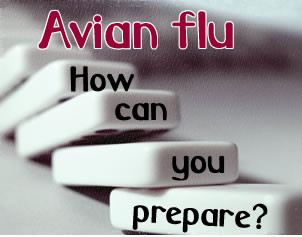 To help employees prepare for a potential pandemic, UNMC Today will publish educational information on avian flu — the most likely candidate — and ways to prepare for such an outbreak. The features will appear each Tuesday. Today, we’ll explain why it’s important employees and their families prepare for such a possibility.
To help employees prepare for a potential pandemic, UNMC Today will publish educational information on avian flu — the most likely candidate — and ways to prepare for such an outbreak. The features will appear each Tuesday. Today, we’ll explain why it’s important employees and their families prepare for such a possibility.
Why prepare for a pandemic?
Stockpiling water, peanut butter and toilet paper for a possible pandemic may seem premature, but many scientists believe it is only a matter of time until the next influenza pandemic occurs.
That’s why UNMC, The Nebraska Medical Center and UNMC Physicians are joining health professionals worldwide in educating individuals on avian flu and how best to prepare should it become the next global disease outbreak.
Health professional say H5N1 influenza — also known as avian, or “bird flu” — poses a monumental challenge to the health care system and communities. As a result, members of UNMC, The Nebraska Medical Center and UNMC Physicians meet regularly to address a range of issues — from workforce and equipment to patient care and supplies — that would be impacted by a pandemic.
“This is going to be a local issue and we all need to take responsibility for preparing ourselves,” said Sharon Medcalf, associate director of the Center for Biopreparedness Education.
Jan Keuchel, infectious control specialist for The Nebraska Medical Center, agrees. “It just makes good sense to prepare and be ready to minimize the damage as much as possible,” she said.
Since 2003, a growing number of human H5N1 cases have been reported in Azerbaijan, Cambodia, China, Djibouti, Egypt, Indonesia, Iraq, Thailand, Turkey and Vietnam. More than half of the people infected with the H5N1 virus have died, according to the U.S. Department of Health and Human Services, which says exposure to infected poultry is the likely cause of most of these cases. Although there has been no sustained human-to-human transmission of the disease, the concern is that H5N1 will evolve into a virus capable of human-to-human transmission.
With the cases so geographically distant, why should Nebraska families prepare for pandemic flu?
- Influenza pandemics occurred three times in the past century — in 1918-19, 1957-58, and 1968-69.
- Virtually every new strain of influenza that has emerged since 1917 — the year when the Spanish flu spanned the globe — appeared first in a bird population before it entered the human population.
- Pandemic flu can be highly contagious and spread rapidly from person to person. Many people would get sick; many could die.
- No one has immunity in a pandemic. Strains also are more virulent and create more severe symptoms, some of which may be lasting, in individuals who are infected.
- Health care services would be in demand, but providers might be in short supply.
- Pandemic flu could severely disrupt everyday life, making it difficult to obtain the goods and services needed.
- Companies are currently working to develop a vaccine, but there are concerns that vaccines developed now may not be effective by the time the flu mutates and is transmissible person-to-person.
For more information, including related Web links, visit the medical center’s avian flu Web site at www.unmc.edu/avianflu.